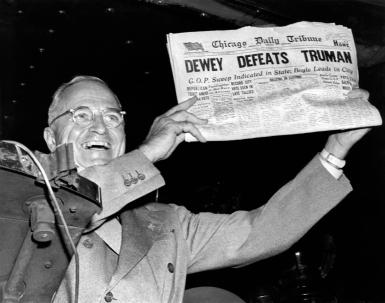
Controversial “tracking” polls have accurately predicted presidential winners in the past.
If you ask most pundits – and indeed, most voters – who’s likely to win the presidential election on November 8th, the answer, overwhelmingly, would be Hillary Clinton. Some odds-makers, including noted statistician Nate Silver, place her chances of victory at somewhere near 90%.
And, of course, a spate of new national polls, most of them sponsored by media companies that unabashedly support Clinton, suggests that the former First Lady enjoys a large and widening lead over Donald Trump.
The race is over, many analysts say.
But not all pollsters agree. In fact, three of the most recent national surveys still show the 2016 contest as a statistical dead heat (or Trump slightly leading). And when non-conforming polls come in threes, they’re not so easy to dismiss as “outliers.” They even beg the question as to whether any of the polls can be trusted to predict the election.
If history is any guide, they can – and these outlier polls may be closer to the truth than many people realize.
For one thing, the firms sponsoring two of the polls have a sterling record. One is IBD/TIPP, which is considered by experts like Silver to be the nation’s single most reliable pollster. Not only did the firm accurately predict the outcome of the last four presidential elections, it did so with uncanny accuracy. Silver found that it came closest to predicting the 2012 election, not just Obama’s victory, but the actual point spread.
And it’s not just IBD/TIPP. The second polling group that finds the current race a dead heat has also successfully predicted past elections. Its sponsor is the LA Times/USC consortium (hereafter LAUSC), a partnership between the nation’s third ;largest newspaper and two prestigious research centers at a prestigious university. In 2012, the group’s polling did feature some rather large rises and dips that some analysts found suspicious. But in the end LAUSC correctly predicted an Obama victory and came within 0.5 percent of being correct on the spread — a close second to IBD/TIPP.
Compare their track record to that of other leading polling firms, especially those that predicted a Romney victory. Most were off by three to four percentage points. Gallup, supposedly an industry leader, was off by a whopping seven points. Clearly, IBD/TIPP and LAUSC are doing something right – very right, it would seem.
Naturally, their track record is also embarrassing to other pollsters, who are better known and for some reason, more widely respected. What’s fascinating is that IBD/TIPP and LAUSC don’t do conventional polling. They use a “tracking” survey which starts with a large sample of survey respondents – like a consumer “panel” — and then measures their shifting views over time. Standard polling is done in a series of recurring snapshots of the total electorate. There is no single pool of respondents. Each new poll draws a fresh sample.
Standard pollsters are highly critical of the “tracking” approach. They say it freezes the voting pool at a single point in time – at the time, it was first created – and can miss important changes in the composition and thinking of the electorate as the race wears on.
But what really seems to irk critics – especially Clinton partisans — is that the IBD/TIPP and LAUSC surveys have tended to find stronger support for Trump, even in the face of new developments in the race – such as the “groping allegations that have caused a sharp swing toward Clinton in many recent polls.

Upon closer examination, there are good reasons to think that the tracking surveys might yield superior results. For example:
- The polls are not based on whether the respondent has voted in a past election. These “likely” voter models are popular in standard polling, but they miss new and still unregistered voters, who tend to favor Trump and who are likely to play a much bigger role in 2016.
- The LAUSC poll is internet-based. Many studies show that voters more honest about their voting preferences when completing internet surveys than they are in phone surveys.
- The IBD/TIPP poll is based on live-interviewers but it includes an unusually high proportion of cell phone users than most standard polls. The poll reaches more of the electorate, and does so more reliably.
- Similarly, the LAUSC polls allows respondent to answer at their leisure, not in the moment. They can take their time to consider their view and are less likely to answer impulsively or reactively.
The proof of the pudding is in the eating, of course. Only the election will prove, in retrospect, which polls were most accurate. But the remarkably predictive record of the two tracking polls should give many analysts pause. In 1948, no one gave Harry Truman any chance of winning the presidency, largely because the polls had showed his opponent Thomas Dewey so far ahead. It’s a cautionary tale: This race may be much closer than you think.